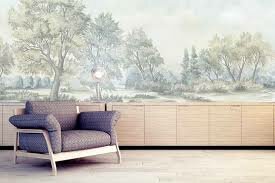
Fashioners love beautiful backdrop for its capacity to change a room. In contrast to normal backdrop, which frequently has a rehashing design, beautiful backdrop fills a whole divider with a solitary, painting like picture. Normally delineating an open air scene, the backdrop brings nature inside and loans old-world intrigue to a space. Simply flip through any ongoing structure magazine and you’ll presumably observe a well-named live with dividers shrouded in enormous scale pictures of blooming vines or influencing trees.
“People embrace things that feel handmade and have a link to the past,” says Susan Harter, who makes hand-painted beautiful backdrop in her Port Townsend, Wash., studio.“At a time when we’re being bombarded with technology, it’s nice to be in a haven of one’s own making. It’s like entering a peaceful mini-Eden.”
As of not long ago, in the event that you needed the look, you needed to spend too much on custom wallcoverings from extravagance brands, for example, Zuber et Cie, Gracie Studio, de Gournay and Fromental. Those handcrafted paper or silk boards can cost a great many dollars, and that is without establishment.
In any case, grand backdrop has turned out to be unmistakably increasingly available. Because of advanced printing innovation that enables retailers to copy the look economically, you never again need to blow your whole designing spending plan on a couple of expensive boards of chinoiserie.
Superior quality printers aren’t actually new to the extravagance backdrop business; the London-based brand Iksel has been creating top of the line advanced accumulations dependent close by painted works since 2004. Furthermore, Harter’s organization, Susan Harter Muralpapers, has been utilizing the innovation for quite a long while to transform her hand-painted paintings into custom canvas wallcoverings.
Presently, mass-showcase retailers are getting in the game: Anthropologie, Minted, Tempaper and U.K.- based Woodchip and Magnolia are only a bunch of the organizations offering lower-estimated variants, making it simpler than at any other time to decorate a clear divider with a painterly picture of a knoll or nursery. Backdrop wall paintings from Anthropologie and Woodchip and Magnolia can be requested online for under $300.
Indeed, even tenants can overhaul their space with a nature-motivated scene: Minted offers dynamic scenes made by autonomous craftsmen in strip and-stick boards, beginning at $330, and Tempaper’s removable backdrop highlights chinoiserie-enlivened sprouts and rich tropical foliage at $12 a square foot.
Beautiful backdrop has been breathing life into homes for over 300 years. Most precedents can be followed back to two distinct styles: Chinese boards and French all encompassing scenes. As per Greg Herringshaw, partner guardian of wallcoverings at the Cooper Hewitt Smithsonian Design Museum in New York, the soonest instances of hand-painted beautifying boards originated from China in the late seventeenth century. They frequently highlighted blossoms, winged creatures and trees, or tradesmen at work, and were rendered in a deliberately credulous, shallow point of view. The ubiquity of chinoiserie took off through the nineteenth century, and the backdrop advanced toward Europe and the United States as an import from the East India Company, following the exchange courses of the time.
French all encompassing papers utilized an increasingly reasonable point of view and demonstrated very nitty gritty scenes. The primary recorded case of an all encompassing paper showed up in France around 1803. It was square printed by hand and credited to Zuber et Cie, the most seasoned as yet working backdrop organization.
“Early French papers were meant to be travelogues that fit with the whole idea of the grand tour, depicting scenes of Roman ruins or exotic lands,” Herringshaw says.
Zuber still uses a similar work concentrated system, which includes cutting structures onto wooden squares, plunging the squares into hand-blended colors, and stepping them onto paper.
In view of its cost and sensational appearance, picturesque backdrop has generally been utilized in high-traffic rooms where guests would be inspired by such a luxurious presentation. (A fine case of Zuber paper decorates the Diplomatic Reception Room in the White House.) Today, you’re still well on the way to detect the wallcoverings in spots where visitors assemble, particularly lounge areas.
“There isn’t usually as much furniture to obstruct the view,” says Alexandria, Va., designer Shazalynn Cavin-Winfrey. “The table and chairs are generally centered in the room as opposed to sitting on the periphery, and they also tend to be more formal spaces.”
The freshly discovered openness of picturesque backdrop enables mortgage holders to tackle an assortment of routine structure issues. Take the ever-present open floor plan: “Paintings are the ideal method to characterize a space,” says Northern Virginia fashioner Alison Giese, who utilized one to outline a lounge area in an open-idea living territory.
Also, for the space-tested, a beautiful scene can have a major effect. “It seems counterintuitive but a mural can make a small space feel much larger,” Herringshaw says.